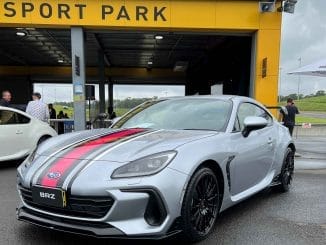Subaru WRX – with the launch of the latest WRX, the safety features in some models are class leading, so its worth having a dedicated article to outline these in detail
WRX Safety – Towards Zero
All-new WRX continues Subaru’s pursuit of one of its most important safety visions to date – working towards zero fatal road accidents in a Subaru vehicle by 2030.
This vision is underscored by four vital safety pillars: Primary, Active, Preventative and Protective safety, all working together to achieve Subaru’s ‘All-Around’ approach to automotive manufacturing.
- Primary safety: Outstanding improvements in occupant comfort and spaciousness to help minimise fatigue and help maximise awareness of surroundings.
- Active safety: Hazard avoidance performance significantly improved through enhanced chassis performance, dynamic handling through tyre grip maximisation and electronic Vehicle Dynamics Control (VDC).
- Preventative safety: WRX models fitted with Subaru Performance Transmission feature the world-renowned EyeSight® preventative safety system which constantly monitors the road ahead and provides driver alerts and intervention as required. All WRX variants feature Vision Assist with Blind Spot Monitor (BSM) and Rear Cross Traffic Alert (RCTA). Reverse Automatic Braking (RAB) has also been added to all WRX variants with the Subaru Performance Transmission.
- Passive safety: Significantly improved body strength and design to absorb impact energy and protect occupants.
At Subaru, ‘driving safety’ is not simply a phrase, it is something on which we focus because a safe vehicle ensures enjoyable driving.
Primary safety
Visibility is important and the excellent visibility provided to drivers by all-new WRX Sedan and Sportswagon means potentially dangerous situations can be quickly detected, promoting confident driving.
The door mirror mounting positions and door pillar shapes have been optimised to reduce blind spots, giving a clearer view so drivers can instantly understand the surrounding conditions, increasing confidence whether cornering out on the open road or managing left and right turns at busy city and suburban intersections.
This high level of visibility helps to enhance driving accuracy.
Active safety
‘Active safety’ means all-new WRX occupants can feel safe, whether they are on a dirt track or a multi-lane highway.
Subaru’s Symmetrical All-Wheel-Drive drivetrain is laterally-balanced within the Subaru Global Platform to provide excellent straight running so drivers can enjoy a variety of driving situations from high speed highway work to local shopping trips in complete confidence.
EyeSight® and Advanced Technologies
The all-new WRX features the new, further evolved Subaru EyeSight® system on selected model grades, giving drivers the enjoyment of stress-free, safe driving with complete peace of mind.
The result of extensive research and development, it helps drivers avoid cyclists and pedestrians who suddenly appear while retaining its existing features, which have themselves been enhanced.
Advanced safety technologies bring enjoyable, stress-free and safe driving with absolute peace of mind and all-new WRX features the new, further evolved EyeSight®* system.
(*EyeSight® is not available for manual transmission variants)
WRX Driving Assist Systems
Eyesight
- Pre-collision Braking System
- Autonomous Emergency Steering
- Emergency Lane Keep Assist
- Lane Departure Prevention
- Lane Centring Function
- Adaptive Cruise Control
- Speed Sign Recognition
- Intelligent Speed Limiter
Vision Assist
- Blind Spot Monitor / Lane Change Assist
- Eyesight Assist Monitor
- Reverse Automatic Breaking
(EyeSight® and Vision Assist features are only available on selected variants)
EyeSight® features include:
Pre-Collision Braking System: Drivers are alerted by a warning display and a warning sound if there is a risk of collision with an approaching vehicle or obstruction.
If the system determines that no avoiding action has been taken it can apply the brakes automatically, avoiding or reducing collision severity. If it detects drivers are not applying enough braking after a potential collision has recognised, it can increase the braking force already being applied.
Autonomous Emergency Steering: In addition to braking control, steering control is also used to assist with collision avoidance immediately before a collision with a vehicle, pedestrian or cyclist because avoidance using only Pre-Collision Braking may not be possible. Autonomous Emergency Steering expands the range of collision types that can be avoided with Pre-Collision Braking.
Emergency Lane Keep Assist: If the vehicle deviates from its lane regardless of following vehicles in adjacent lanes or oncoming vehicles, and it is within the comfortable vehicle speed range, a warning screen is displayed, and an alarm buzzer sounds to alert the driver to the danger. Steering operations can also be assisted to help prevent lane departure.
Lane Centring Function: If the system recognises lane markers or a preceding vehicle while the vehicle is being driven using Adaptive Cruise Control, the vehicle will either hold position near the centre of the lane or assist with steering operations to remain following the preceding vehicle.
The precise and natural-feeling movements of the Lane Centring system reduce driver stress during long and monotonous highway driving or in traffic jams, making driving in all-new WRX a pleasant experience.
Adaptive Cruise Control: Vehicles approaching from the sides are detected and their movements predicted. Overtaking vehicles as soon as possible allows for smooth, natural control with drivers having no feeling of suddenly being in a dangerous situation.
Adaptive Cruise Control also checks and predicts the movement of the preceding vehicle as it changes lanes and prepares to accelerate before that vehicle has completely left the lane.
Speed Sign Recognition: Speed Sign Recognition can recognise speed limit signs and displays the speed limit on all-new WRX’s multi-information display, assisting drivers from inadvertently overlooking speed limits.
Speed Sign Recognition contributes to improved safety by assisting drivers to avoid speed limit violations and creating an environment in which drivers can focus on driving.
Intelligent Speed Limiter: An Intelligent Speed Limiter is used for fifth-generation WRX. It can be set to automatically adjust the vehicle speed limiter to match the speed limit signs recognised by the Speed Sign Recognition system.
Speed limits change frequently on Australian roads and automatically adjusting the vehicle’s speed limiter can contribute to the prevention of serious accidents by reducing the burden on drivers.
Vision Assist
Reverse Automatic Braking (RAB): RAB employs four rear bumper-mounted sensors to detect obstructions when reversing. If there is a risk of collision the system alerts the driver.
If the driver fails to apply the brakes or take any other evasive action the system can automatically apply the brakes to help avoid or reduce the severity of a collision.
Blind Spot Monitor (BSM) and Lane Change Assist (LCA): The Blind Spot Monitor (BSM) system uses radar sensors installed at the rear of all-new WRX to detect objects and vehicles behind, alerting drivers with door mirror housing-mounted LED indicators that blink or become solidly lit when something is detected.
Blind Spot Detection (BSD) alerts drivers of the presence of a following or overtaking vehicle in the car’s rear blind spot area and obstructed by the C-pillar.
Lane Change Assist (LCA) informs drivers when vehicles approaching from behind in an adjacent lane are detected if the driver indicates to signal a lane change.
Rear Cross Traffic Alert (RCTA): Rear Cross Traffic Alert (RCTA) alerts drivers to vehicles detected approaching from either side while the car is being reversed.
Front View Monitor (FVM) and Side View Monitor (SVM): The Front View Monitor (FVM) and Side View Monitor (SVM) are helpful when checking for safety around the car and also further reduce driver stress when checking road conditions or avoiding obstacles during off-road driving.
For this latest generation of the system both the FVM and SVM are equipped with an improved, higher definition digital camera.
Auto-dipping passenger-side door mirror: Selected WRX variants feature a passenger-side door mirror which automatically tilts downward when reverse gear is selected to improve visibility when reversing.
Tilting the mirror at a downward angle captures the road surface around the rear passenger side tyre, providing extra visibility for parking.
Driver Monitoring System: Available on selected WRX variants, the Driver Monitoring System uses a camera installed above the Centre Information Display to continuously monitor driver. It:
- supports safe driving by warning drivers as necessary with audible warnings and flashing indicators
- in addition to the audible warnings and flashing indicators the system also uses visual alerts on the instrument display whenever drivers are detected taking their eyes off the road or show signs of drowsiness
- has a dedicated camera with facial recognition which on certain model variants automatically adjusts the driver’s seat position, door mirror angles, air-conditioning settings, and other display settings when a known person takes the driver’s seat and can register as many as five individual drivers, greatly increasing convenience.
Passive safety – Sedan
All-new Subaru WRX’s passive safety is enhanced with a collision-safety body that has been refined and features a body structure optimised through the use of the Subaru Global Platform and high-tensile strength steel sheets, to help minimise damage in the event of an accident.
As well, improvements in collision safety have also been made to the car’s front, sides and rear.
As well as the full inner-frame structure which adds rigidity to the body the closing plate thickness of the forward chassis rail has been increased from 1.6mm to 1.8mm to manage the vehicle’s increased weight and the additional framework added to the sides of the transmission tunnel.
The increased use of hot-pressed materials and high tensile steel increases collision performance while decreasing weight.
Side collision structures have been improved with the use of a composite material comprised of bonded and laser welded steel plates of varying strengths adopted for the B-pillar. As well, 980 MPa steel has been used in the sill area to further strengthen the cabin.
Passive safety – Sportswagon
Collision-safety has also been evolved to match the WRX Sportswagon’s particular characteristics with high-tensile steel sheets used to optimise the body structure in a logical layout and superior collision safety structures have been engineered at the front, sides and rear of the vehicle.











